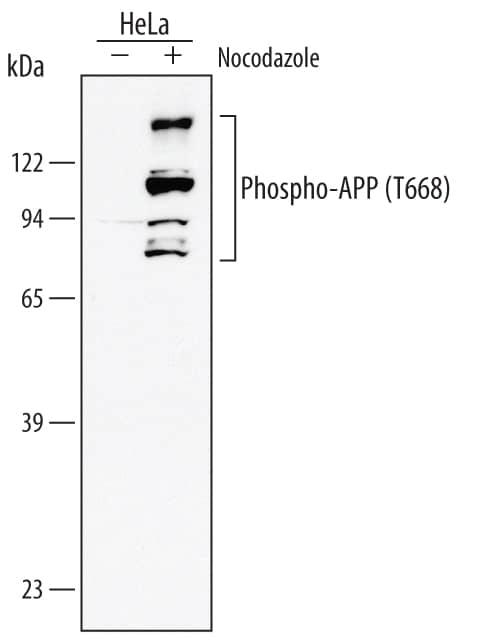Human/Mouse Phospho-APP/Protease Nexin II (T668) Antibody
R&D Systems, part of Bio-Techne | Catalog # MAB2508

Key Product Details
Validated by
Species Reactivity
Applications
Label
Antibody Source
Product Specifications
Immunogen
Specificity
Clonality
Host
Isotype
Scientific Data Images for Human/Mouse Phospho-APP/Protease Nexin II (T668) Antibody
APP/Protease Nexin II in Human Alzheimer's Disease Brain.
APP/Protease Nexin II was detected in immersion fixed paraffin-embedded sections of human Alzheimer's disease brain (cortex) using 8 µg/mL Human/Mouse Phospho-APP/Protease Nexin II (T668) Monoclonal Antibody (Catalog # MAB2508) overnight at 4 °C. Tissue was stained with the Anti-Mouse HRP-DAB Cell & Tissue Staining Kit (brown; Catalog # CTS002) and counterstained with hematoxylin (blue). View our protocol for Chromogenic IHC Staining of Paraffin-embedded Tissue Sections.Detection of Human Phospho-APP/Protease Nexin II (T668) by Western Blot.
Western blot shows lysates of HeLa human cervical epithelial carcinoma cell line untreated (-) or treated (+) with 1 µg/mL nocodazole for 16 hours. PVDF membrane was probed with 1 µg/mL of Human/Mouse Phospho-APP/Protease Nexin II (T668) Monoclonal Antibody (Catalog # MAB2508), followed by HRP-conjugated Anti-Mouse IgG Secondary Antibody (Catalog # HAF007). This experiment was conducted under reducing conditions and using Immunoblot Buffer Group 1.Applications for Human/Mouse Phospho-APP/Protease Nexin II (T668) Antibody
Immunohistochemistry
Sample: Immersion fixed paraffin-embedded sections of human Alzheimer's disease brain (cortex)
Western Blot
Sample: Nocodazole-treated HeLa human cervical epithelial carcinoma cell line
Formulation, Preparation, and Storage
Purification
Reconstitution
Formulation
Shipping
Stability & Storage
- 12 months from date of receipt, -20 to -70 °C as supplied.
- 1 month, 2 to 8 °C under sterile conditions after reconstitution.
- 6 months, -20 to -70 °C under sterile conditions after reconstitution.
Background: APP
Amyloid precursor protein (APP) is a type I membrane protein with several human isoforms due to alternative splicing. APP-770, -751, and -733 contain a Kunitz protease inhibitor (KPI) domain (residue 291 - 342) and APP-695 does not. APP is a cell surface molecule with many functions. It can be processed proteolytically in two different pathways. In one pathway, beta- and gamma-secretase cleave at the beta site between residue 670 and 671 and the gamma site between residue 711 and 714 to produce beta‑amyloid peptide (A beta40 and A beta42), a major component in plaques found in brains of patients with Alzheimer's disease (1). The other pathway involves alpha-secretase that cleaves residues between 687 and 688. It is antiamyloidogenic due to its benign character and the prevention of the A beta peptide formation (2). Soluble APP containing the KPI domain, also referred to as protease nexin II, is a potent inhibitor of serine proteases and may have additional functions. For example, it may regulate the contact face of blood coagulation and limit thrombosis specially in brain due to its localization and coagulation factor XI inhibiting activity (3, 4).
References
- Haass, C. (2004) EMBO J. 23:483.
- Lichtenthaler, S. F. and C. Haass (2004) J. Clin. Invest. 113:1384.
- Badellino, K.O. and P.N. Walsh (2000) Biochemistry 39:4769.
- Xu, F. et al. (2005) Proc. Natl. Acad. Sci USA. 102:18135.
Long Name
Alternate Names
Gene Symbol
Additional APP Products
Product Documents for Human/Mouse Phospho-APP/Protease Nexin II (T668) Antibody
Product Specific Notices for Human/Mouse Phospho-APP/Protease Nexin II (T668) Antibody
For research use only

